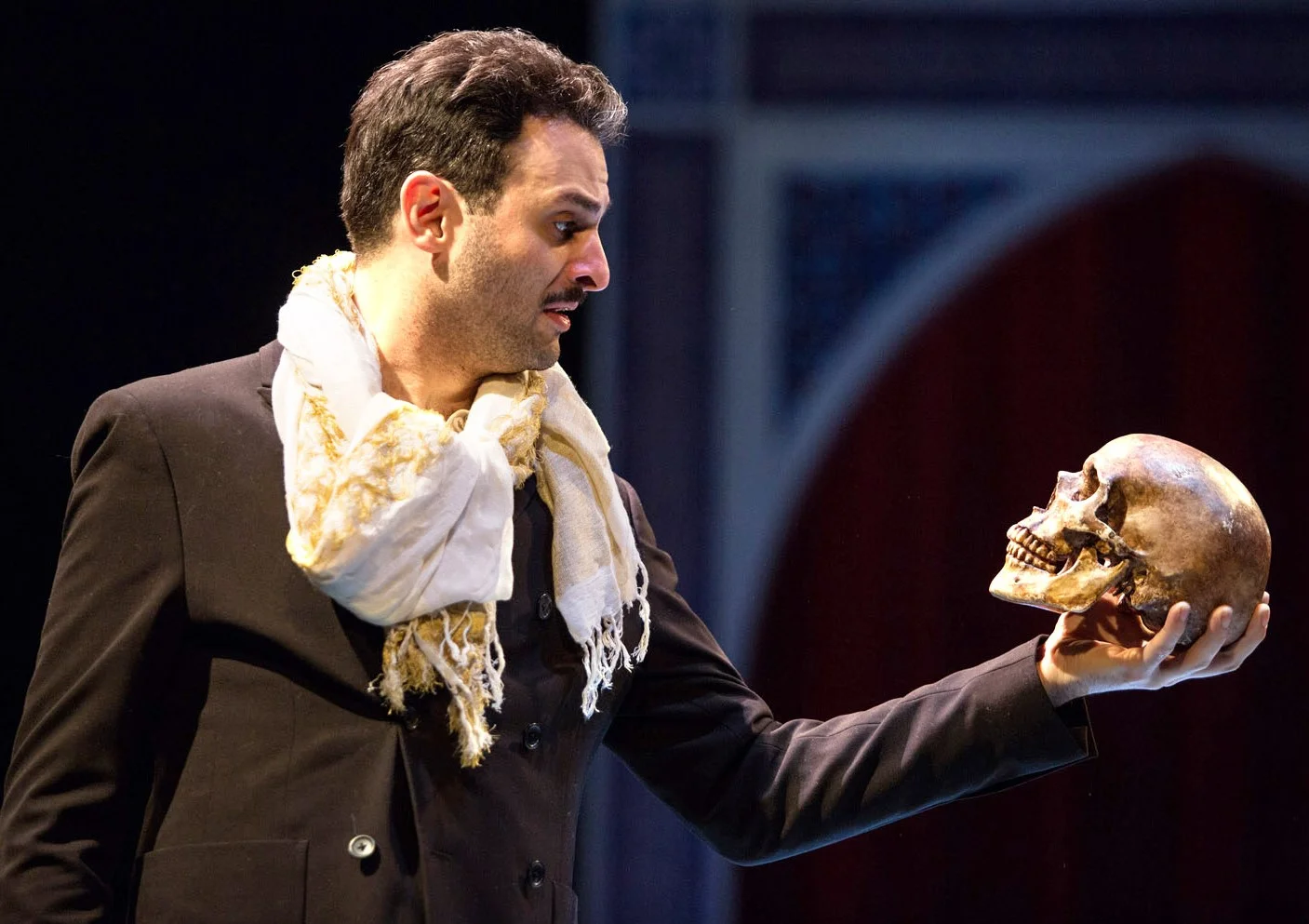Waterwell’s production of Hamlet is probably not for the first-timer to Shakespeare’s masterpiece. Under director Tom Ridgely, the tragedy has been reset in Iran of the early 20th century rather than Denmark of the 1500s. Parts of the play are spoken in Farsi, and if, for instance, you didn’t know what Hamlet’s father’s Ghost says to him, you’re going to be out of luck, since the physically and vocally formidable Barzin Akhavan speaks entirely in Farsi. Other passages require familiarity with the play to be understood, notably Hamlet’s exchange with Ophelia about lying in her lap during The Murder of Gonzago, or Hamlet’s crucial plan to insert lines of his own. (The last, however, is covered by some English dialogue later, but until that arises, a new listener would be confused.)
Arian Moayed (right) is Hamlet and Abraham Makany is Marcellus in Waterwell’s production of Shakespeare’s tragedy. Top: Hamlet with Yorick’s skull.
Although Ridgely’s note in the program says, “The alternation between the two languages places these two cultures in continual tension,” in practice the parts more often war with each other. Still, who doesn’t know Hamlet a little bit? If not from seeing the play, then from the movie versions with Laurence Olivier, Mel Gibson or Kenneth Branagh? And there are similarities in the authoritarian bents of both eras, so Ridgely’s initial impulse isn’t entirely off the wall. The exchange of ambassadors to Norway and the march of Fortinbras to Poland survive to lend an impression of completeness, too. But although some cuts have been judicious, other aspects distract from the story, which begins traditionally, on the battlements with Horatio and the guards, Marcellus and Bernardo, clad in black uniforms and karakul caps.
The discord between text and visuals begins almost immediately, however. Horatio describes the Ghost as wearing armor—but he doesn’t. Akhavan appears in khaki uniform with epaulettes, and a taj on his head. When the prince first appears, it is not, as he describes it, wearing an “inky cloak” of black. Costumer Nina Vartanian has dressed him in a dark olive suit. Yet if wearing black is the yardstick by which to judge sorrow, then Polonius, Voltemand, and even the guards are far more distraught over his father’s death. Why, then, ignore the reference to the internal stage direction and forgo an “inky cloak”? (Vartanian’s work does include some stunningly colorful clothing, and splendid martial attire, too.)
Sherie Rene Scott (left) is Gertrude, and Ajay Naidu is Polonius in Hamlet.
The oddities go beyond costuming. The scene where Hamlet insists that Guildenstern play a recorder, Guildenstern balks, and Hamlet berates him with “You play upon me! You would seem to know my stops…” is now unaccountably altered so that Hamlet gives Horatio a recorder to play on. The scene barely begins before it abruptly ends, and it makes no sense.
Ridgely occasionally has an alteration that is strikingly successful, especially “To be or not to be,” which he has moved from the nunnery scene early in Act III to the end of Act IV, after Claudius and Laertes plot to kill Hamlet in the duel. It’s extremely effective there—and very well delivered by Arian Moayed’s prince, though Moayed takes time to find his groove in the part, improving steadily throughout.
One suspects that attention to the “concept” has left some actors to their own devices. In any case, there’s a good deal of speechifying and not enough music in the language. Sherie Rene Scott, a fine singer and performer who is surely endowed with a sense of rhythm, is elegant, statuesque and dull as Gertrude. And Micah Stock’s lumpish, squishy Horatio frequently seems a borderline buffoon. It’s a puzzle that he and Hamlet are friends. Ajay Naidu’s hyperactive Polonius barks his lines and punches the verse, and although his creation of a huckster for the monarchy rather than a doddering sage is an inventive departure from tradition, eventually it grows tiresome.
Sheila Vand plays Ophelia. Photos by Eric Michael Pearson.
Among the other performances are a fine Laertes from the strapping Amir Arison and a well-spoken Ophelia from Sheila Vand. Andrew Ramcharan Guilarte as Claudius is exceptionally good: kingly, romantic, ruthless in bearing, clear and persuasive in his speaking. And it is startling to hear Voltemand and Osric so capably delivered by Sathya Sridharan, with a real sense of how to make heightened language sound utterly natural.
Moayed, a fine actor, starts out more diffident and less melancholy than one expects. His Hamlet gives little indication that he’s a tinderbox ready to be sparked by the Ghost’s news; he is certainly bookish, but he only becomes aroused after the encounter with the Ghost (thrillingly staged, as are all the spirit’s appearances). By the end, though, he is more compelling, and he has high points not only with “To be or not to be” but also “Alas, poor Yorick,” which becomes a weepy aria.
Mohsen Namjoo has contributed Persian-flavored music that, along with Jason Simms’s spread of Oriental rugs around a raised circular playing platform with a floor of lapis lazuli, deftly conjures the East. The production may aim for revelations about Hamlet by resetting it in Iran, but the payoff is spotty.
Waterwell’s production of Hamlet runs through June 3 at the Sheen Center (18 Bleecker St.) Evening performances are at 7 p.m. on Wednesday and Thursday, and 8 p.m. Friday through Sunday; matinees are at 2 p.m. Saturday and Sunday; there will be a special 1 p.m. matinee on May 31. For tickets and information, call the box office at (212) 925-2812 from 11 a.m. to 5 p.m. and one hour before performances, or visit sheencenter.org.






